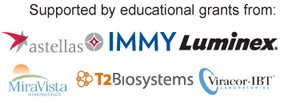Title: Earlier Treatment of Invasive Fungal Infections: Are We There Yet?
Statement of Need
While early diagnosis and initiation of appropriate antifungal therapy are crucial to assure optimal outcomes for patients with invasive mycoses, there are many barriers to early, effective management. Better screening methods and newer diagnostic techniques, when effectively employed, should enable more rapid and accurate diagnoses of these challenging infections. Furthermore, appropriate use of current and emerging antifungals with enhanced antifungal spectra should also afford better outcomes despite changing epidemiologic trends and the emergence of resistant pathogens. This educational activity—Earlier Treatment of Invasive Fungal Infections: Are We There Yet?—challenges the audience to assess whether we are now in an era in which appropriate diagnostics and therapeutics can be employed early in the management of invasive mycoses to improve antifungal outcomes. The initiative uses case-based learning and a panel-discussion format to address the current status of management of aspergillosis, candidiasis, cryptococcal, and endemic fungal infections.
Learning Objectives
After completing this activity, the participants will be better able to:
- Define the barriers to early treatment of invasive fungal infections
- Employ currently available and emerging diagnostics for invasive fungal infections, thus assuring the earliest diagnosis possible
- Choose appropriate therapies for early management of invasive fungal infections
Target Audience
This activity is directed to infectious disease physicians, hematologists/oncologists, critical care physicians, transplant physicians, pathologists, and other healthcare providers responsible for the management of invasive mycoses.
Accreditation
The University of Nebraska Medical Center, Center for Continuing Education is accredited by the Accreditation Council for Continuing Medical Education to provide continuing medical education for physicians.
The University of Nebraska Medical Center, Center for Continuing Education designates this live activity for a maximum of 2.0 AMA PRA Category 1 Credit(s)™. Physicians should claim only the credit commensurate with the extent of their participation in the activity.
ADA
In compliance with the Americans with Disabilities Act, the UNMC Center for Continuing Education does not discriminate on the basis of disability. The Center shall provide reasonable accommodation, including auxiliary aids and services, to ensure equal access to its services and activities. If you would like an auxiliary aid or service, please call 402-559-9250 by August 15, 2012 with your request.
Disclosure Policy
It is the policy of the UNMC Center for Continuing Education to ensure balance, independence, objectivity, and scientific rigor in all its educational activities. All faculty participating in this activity are expected to disclose to the audience any financial interest or other relationship he/she has with the manufacturer(s) of any commercial product(s) discussed in an educational presentation.
Additional Information
There is no charge for this activity.
This activity is supported by an independent educational grant from Astellas Scientific and Medical Affairs Inc., IMMY, Luminex, Mira Vista Diagnostics, T2 Biosystems, and Viracor-IBT.
This event is neither sponsored nor endorsed by the American Society for Microbiology.
For further information, contact Tom Davis by telephone (877-276-4523), fax (805-648-8070), or email (tdavis@terranovamedica.com).


Aspergillus fumigatus image provided courtesy of Dr. David Ellis and the University of Adelaide.
Cryptococcus neoformans image provided courtesy of Gross L (2006) Iron Regulation and an Opportunistic AIDS-Related Fungal Infection. PLoS Biol 4(12): e427. doi:10.1371/journal.pbio.0040427

